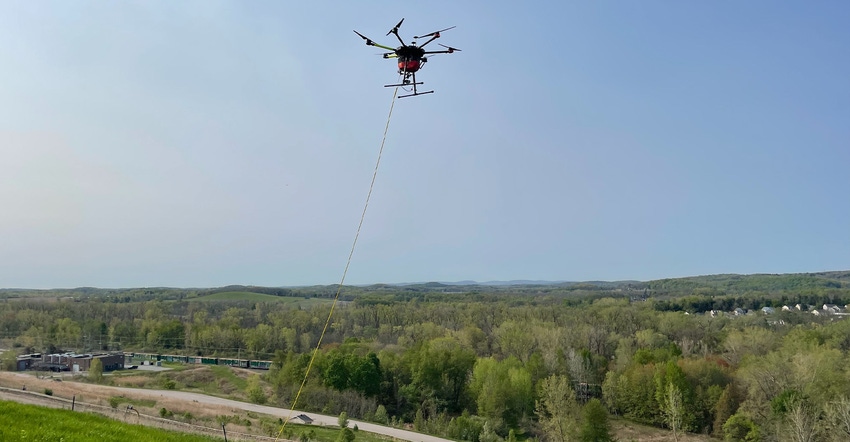Methane is the second most prevalent manmade greenhouse gas (GHG) worldwide, and municipal solid waste landfills are the third-largest contributor in the United States. With better gas collection and control systems and improved operations, the industry is getting better at curbing emissions.

Methane is the second most prevalent manmade greenhouse gas (GHG) worldwide, and municipal solid waste landfills are the third-largest contributor in the United States.
With better gas collection and control systems and improved operations, the industry is getting better at curbing emissions. Still, active sites leak methane, driving new innovations to tackle the problem, especially as regulations tighten, and as the U.S., along with Europe, has pledged to cut these emissions by 30% by 2030.
Some landfills working to improve in this space are relying on drones or unmanned aerial vehicles equipped with gas detection and analysis apparatus.
Drones come with advantages such as the ability to cover more ground and capture data quicker than handheld devices; are safer for workers; and can navigate landfill contours well.
A few developers market their systems as tools to measure and report emissions and identify leaks. But Art Mohr, founder and owner of Sniffer Robotics, says his company’s technology, SnifferDRONE, stands out from others. The reason he says, is that it measures methane concentrations and detects leaks directly on the ground, at the specific emitting source.
He explains:
“Other systems use laser to measure from above the ground. They are measuring methane within a column of light from the drone to the ground. So, they are reporting average concentrations (parts per million per meter) over the length of that column. But because our system measures directly at the ground, we get data that accurately and precisely reports leak locations right at the source.”
Internal verification has shown the technology to be 90% accurate at determining leak locations.
Onboard components include a computer and software to perform functions such as processing methane measurements and localizing methane leaks to specific GPS coordinates.
The patented system also includes a hose that extends to the ground during flights, pumping gas samples to an onboard detector. An air inlet nozzle, attached to the hose, is key to the ability to collect samples direct from the ground. The nozzle remains properly positioned at the ground with help from the onboard laser system that monitors the distance between the drone and ground and adjusts the craft’s altitude to maintain the pre-determined distance as it flies.
SnifferDRONES have flown more than 30,000 acres of landfills in 25 states, mainly for leak detection but also for emissions quantification. Customers are large waste companies, including Waste Connections, Waste Management, GFL Environmental, and Casella, and Mohr does business with municipal site owners as well as renewable natural gas (RNG) project developers.
Sniffer provides comprehensive leak location data, emissions quantification, and further analytics on request. This information provides data intended to help improve operations and compliance performance, among benefits.
The ability to detect emissions and leaks comes with obvious environmental benefits, but some landfill operators are beginning to leverage drones in their quest to improve the efficiency of their gas-to-energy projects.
“If you don’t capture the gas—rather emissions are lost in the atmosphere—it’s lost revenue. From an RNG valuation, an operator’s lost sales could be millions annually,” Mohr says.
GFL uses SnifferDRONE at Arbor Hills Landfill in Northville, MI. David Pepper, vice president, Post-Collections Support, GFL Environmental, says the technology has allowed for sound, expeditious decision making.
Comparing it to handheld surface emissions monitoring (SEM) that requires workers to walk a path and upload data they capture, he says, “We get the data quickly and in a format that’s easy to read.”
GFL bought Arbor Hills as part of a divestiture during a merger of Advanced Disposal and Waste Management. The drone came on the scene prior to the transaction, after the surrounding community complained of odors. It was leveraged to help determine the source and ultimately remediate. (While methane is odorless, other gases commonly emanate from the same location; first identifying methane leaks using the drone can help isolate the offending gases.)
“Since we took ownership, we continue to use the technology to make informed decisions about how to manage the facility and to minimize impacts,” Pepper says, commenting the system was instrumental in pinpointing where to place a cover to help improve collections, as the data indicated where the highest emissions were.
And the technology has helped inform business decisions to ensure best placement of gas collection system components, “for instance helping determine where we need to install new wells to improve wellfield performance,” Pepper says.
With drones, sites can be scanned in about half the time as with manual SEM methodology.
And there’s the safety factor. “Drones take people off landfills in many cases. They may otherwise walk 20 miles carrying a handheld detector while encountering slip, trip, fall hazards with soil erosion and unstable walking areas. Sometimes they are walking on snow or encounter wild animals,” Mohr says.
But the data has to be captured one way or another. Under its New Source Performance Standards (NSPS; Method 21), the U.S. Environmental Protection Agency (EPA) requires that landfills be inspected four times a year for leaks, and operators have 30 days to remediate should there be a problem.
Sniffer has submitted an application to EPA to market its drone as an alternative to SEM, and would sell the craft pending approval, but for now is only able to sell drone services.
Speaking broadly of industry needs, Mohr says leak detection has to improve.
“Landfills are complex, living, breathing systems and ever changing. Though many are trying to develop a perfect solution to monitor methane emissions, all systems today remain imperfect.
When you think of where regulations are heading, and as operators try to better account for methane emissions, it is important to detect leaks, and to do it more accurately and credibly.”
About the Author(s)
You May Also Like




